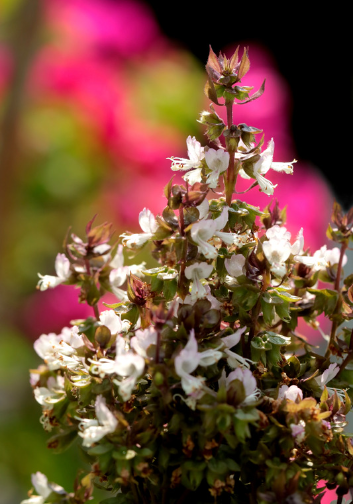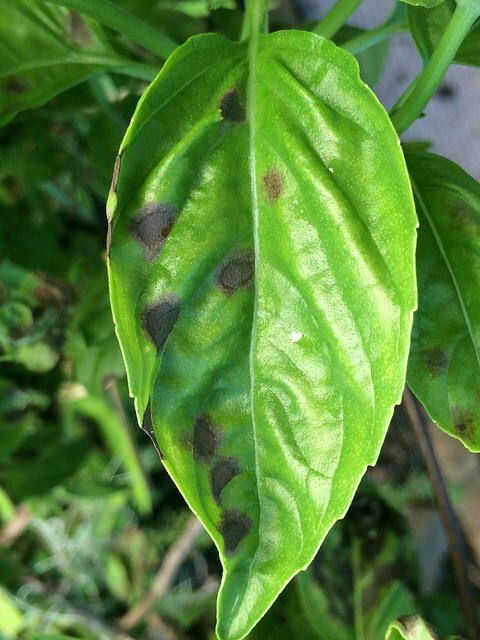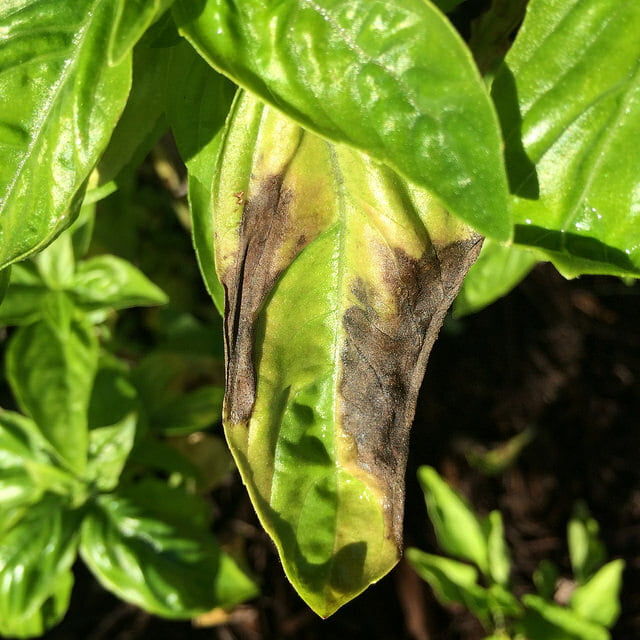Licorice basil is a strong, flavorful variety of basil which grows into vibrant green plants with hints of purple on the foliage. A type of Thai basil, these plants are not only beautiful, but reward growers as an immensely fragrant addition to the home garden. As the name would imply, both licorice and anise are prevalent in the flavor of the basil. Licorice, growing in the ground or in containers, thrives in warm weather climates which receive ample sunlight.

All types of basil grow easily in warm, sunny weather. The leaves are commonly used in cooking, but the flower buds are also edible. This fast-growing herb thrives equally well in gardens and containers. With sufficiently warm weather, new basil plants are ready for pruning (to encourage bushier growth) in about six weeks.
| Common Name | Basil |
| Botanical Name | Ocimum basilicum |
| Family | Mint |
| Plant Type | Perennial or annual herb |
| Size | 18–24 in. tall and wide |
| Sun Exposure | Full sun (likes some shade in very hot climates) |
| Soil Type | Somewhat rich soil |
| Soil pH | 5.1–8.5 (acidic to alkaline) |
| Bloom Time | June to frost |
| Hardiness Zones | 10–11 (grown as an annual elsewhere) |

When to Plant?
This will be determined by your planting zone. There is a final frost date for each area. As a result, you can plan your gardening activities around this date. Check our Frost Dates Across North America: First & Last Frost Dates Chart. However, the date will not be the same for every plant. Basil should be planted after the last spring frost. You can plant during the summer as well.
How to Plant
To plant basil seeds, you need a 0.25 to 0.5 gallons pot or large container at least 6″ deep so that the basil shoots can grow at least 4″ apart. A container for growing basil must necessarily have drainage holes.
If your container does not have drain holes, add stones to the container’s bottom to act as a drain. Plant basil in well-drained, fertile soil with direct sunlight for at least 6 – 8 hours a day.
The soil temperature for planting basil should be 50°F – 70°F. The first sprouts of the basil will appear in 7 – 12 days.

When growing basil, it is best to use larger pots. The smaller the pot, the more often the plant needs to be watered. On hot summer days, the soil can dry out, which will harm the plant. A sunny windowsill is an ideal spot to grow basil. The best time to plant basil is late in the day or early morning so that the plant is not immediately exposed to the scorching sun. Companion planting: Plant basil among other herbs and vegetables with similar lighting and watering needs, e.g., parsley or tomatoes. Some people say tomatoes taste better when they neighbor basil. Plant basil alongside chamomile, lettuce, oregano, and peppers.
How to Cultivate
Sun – Needs at least six hours of sun per day.
Spacing – If planting more than one, space the basil plants about 4 inches apart to allow for growth.
Water – Large beds or planter boxes may only need water every 3 – 4 days.
Soil – Basil loves moist, rich, well-drained soil with a pH of 6.0 – 7.0.
How to Harvest
When propagated by seeds, the crop is harvested in about 2 – 2.5 months from the appearance of the first shoots.
Once the basil plant is 6 – 8 inches tall, you can harvest it.
Basil has no specific harvest time – just choose any time you want, and do it the way you want it.
Another nice thing is that the more often you harvest, the more basil you get.
Harvest before the seeds form. When basil goes to seed, the leaves will often have a bitter flavor.
Hydroponics
Germination: Start by germinating Licorice basil seeds using a seed starter kit or by placing them in a damp paper towel until they sprout. Once the seeds have sprouted, you can transfer them to your hydroponic setup.
pH range: The optimal pH range for Licorice basil hydroponic growth is between 5.5 and 6.5. Use a pH meter or test kit to monitor the pH levels and adjust accordingly using pH up or pH down solutions.
EC: The ideal electrical conductivity (EC) range for Licorice basil hydroponic growth is between 1.2 and 2.0 mS/cm. Measure the EC levels of your nutrient solution regularly and adjust as needed.
PPM: The recommended range for nutrient solution strength, as measured in parts per million (PPM), is between 1000 and 1400 PPM for Licorice basil.
Humidity: Licorice basil prefers moderate to high humidity levels, ideally between 50% and 70%.
Light hours: The plant requires between 12 and 16 hours of light per day for optimal growth. Use LED grow lights or natural sunlight to provide the necessary light.
Temperature air: Licorice basil grows best in a warm environment with temperatures between 68 and 86°F (20-30°C). Keep the temperature stable and avoid sudden changes.
Temperature water: The ideal water temperature for Licorice basil hydroponic growth is between 68 and 77°F (20-25°C).
Overall, hydroponic plants require consistent monitoring and adjustments to their environment to ensure healthy growth. With proper care and attention, you should be able to harvest a bountiful crop of fresh and nutritious herbs.
Common Pests and Diseases
Cercospora leaf spot (Cercospora ocimicola)
Symptoms: Circular to irregular dark spots on leaves with light centers
Cause: Fungus
Management
Avoid overhead irrigation and splashing plants with water, instead water plants from the base and apply a layer of mulch around the plants to reduce water splash; remove and destroy any symptomatic leaves; minor infections can be controlled by spraying weekly with a fungicide containing potassium bicarbonate

Downy mildew (Peronospora belbahrii)

Symptoms: Yellowing leaves; discoloration often begins around the middle vein and spreads outwards; gray fuzzy or downy growth on the lower surface of the leaves; brown to black angular necrotic patches on the plant.
Cause: Fungus
Management
Grow tolerant varieties; apply protective fungicide; ensure good air circulation around greenhouse grown plants; use drip irrigation to avoid wetting foliage.


